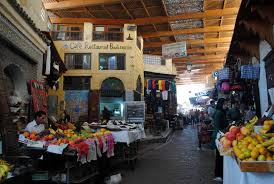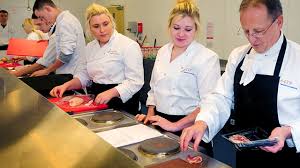Exploring the Flavours of Morocco: Moroccan Main Dishes
Moroccan cuisine is a vibrant tapestry of flavours, aromas, and textures that reflect the country’s rich history and diverse cultural influences. At the heart of every Moroccan meal are the main dishes, which are a true celebration of traditional ingredients and culinary techniques.
Tagine
One cannot talk about Moroccan main dishes without mentioning tagine. This iconic dish takes its name from the earthenware pot in which it is cooked. Tagine typically consists of slow-cooked meat (often lamb or chicken) or fish, combined with a variety of vegetables, fruits, nuts, and an array of aromatic spices such as cumin, cinnamon, and saffron. The result is a tender and flavourful stew that is often served with couscous or bread.
Couscous
Couscous is another staple in Moroccan cuisine and is considered a national dish. This tiny steamed semolina pasta is often paired with a rich stew made from meat (such as lamb or chicken), vegetables, chickpeas, and a blend of spices. The art lies in the preparation of the couscous itself – it must be fluffy and light to complement the hearty flavours of the stew.
Bstilla
Bstilla (or pastilla) is a unique dish that showcases the fusion of sweet and savoury flavours in Moroccan cooking. Traditionally made with pigeon meat (though now often substituted with chicken), this pastry pie combines layers of thin filo dough with spiced meat filling, almonds, eggs, and a dusting of powdered sugar and cinnamon. The result is a delectable dish that tantalises the taste buds.
Harira
Harira is a hearty soup that holds a special place in Moroccan cuisine, especially during Ramadan. This tomato-based soup typically contains lentils, chickpeas, rice, vegetables such as onions and celery, herbs like coriander and parsley, as well as spices like ginger and cinnamon. Harira is not only delicious but also nourishing – making it a comforting main dish for many Moroccans.
Moroccan Grilled Meats
Morocco’s love for grilled meats shines through in dishes like kebabs (skewered meats), merguez (spicy lamb sausages), and mechoui (slow-roasted lamb). These dishes are often seasoned with traditional blends such as ras el hanout or charmoula before being grilled to perfection over charcoal. Served with salads or bread on the side, these grilled meats are popular choices for casual dining in Morocco.
In conclusion, Moroccan main dishes offer a sensory journey through centuries-old culinary traditions that continue to enchant food lovers around the world. From fragrant tagines to delicate couscous and flavourful grilled meats – each dish tells a story of Morocco’s diverse heritage and gastronomic prowess.
Exploring Moroccan Main Dishes: Traditional Recipes and Cultural Significance
- What is a traditional Moroccan main dish?
- What are the key ingredients in a Moroccan tagine?
- How is couscous prepared in Moroccan cuisine?
- What is the significance of bstilla in Moroccan cooking?
- Can you explain the cultural importance of harira soup in Morocco?
- What are some popular types of grilled meats in Moroccan cuisine?
What is a traditional Moroccan main dish?
A traditional Moroccan main dish that often takes the spotlight is the iconic tagine. Named after the earthenware pot it is cooked in, tagine features a delightful blend of slow-cooked meat (commonly lamb or chicken), vegetables, fruits, nuts, and an array of aromatic spices. This hearty stew captures the essence of Moroccan cuisine with its tender textures and rich flavours, making it a beloved choice for both everyday meals and special occasions. The communal act of sharing a steaming tagine dish embodies the warmth and hospitality that are deeply ingrained in Moroccan culinary traditions.
What are the key ingredients in a Moroccan tagine?
A Moroccan tagine is a quintessential dish that encapsulates the essence of Moroccan cuisine. The key ingredients in a Moroccan tagine typically include tender meat (such as lamb or chicken), an assortment of vegetables like carrots, potatoes, and tomatoes, dried fruits such as apricots or prunes for a touch of sweetness, nuts like almonds or pistachios for crunch, and a blend of aromatic spices including cumin, cinnamon, turmeric, and paprika. This harmonious combination of ingredients creates a rich and fragrant stew that is slow-cooked to perfection in a traditional earthenware tagine pot, resulting in a dish that is both comforting and full of complex flavours.
How is couscous prepared in Moroccan cuisine?
In Moroccan cuisine, preparing couscous is a meticulous process that involves steaming tiny grains of semolina until they are light and fluffy. The couscous is traditionally cooked in a special pot called a couscoussier, where the grains are steamed over simmering broth or water. The key is to ensure that each grain remains separate and tender. Once cooked, the couscous is fluffed with a fork to break up any clumps and enhance its texture. This versatile staple can be served as a base for savoury stews, mixed with vegetables and meats, or enjoyed on its own as a satisfying side dish. The art of making couscous in Moroccan cuisine reflects the country’s dedication to creating dishes that are not only delicious but also steeped in tradition and cultural significance.
What is the significance of bstilla in Moroccan cooking?
Bstilla, also known as pastilla, holds a significant place in Moroccan cooking due to its unique blend of sweet and savoury flavours that symbolise the country’s culinary diversity. This traditional dish, often made with pigeon meat but now commonly prepared with chicken, showcases Morocco’s ability to harmoniously combine ingredients like almonds, eggs, spices, and filo pastry. The dusting of powdered sugar and cinnamon on top adds a touch of decadence to the rich and fragrant filling. Bstilla is not just a meal but a cultural symbol that reflects the intricate layers of Moroccan cuisine, making it a must-try for those seeking an authentic taste of Morocco.
Can you explain the cultural importance of harira soup in Morocco?
Harira soup holds significant cultural importance in Morocco as it is not just a dish but a symbol of tradition, community, and spirituality. This hearty soup is commonly enjoyed during the holy month of Ramadan, where it is traditionally served to break the fast at sunset. The rich blend of ingredients in harira, including lentils, chickpeas, vegetables, and spices, provides nourishment and sustenance after a day of fasting. Beyond its nutritional value, harira embodies the spirit of sharing and togetherness as families and communities come together to enjoy this comforting soup. Its preparation and consumption during Ramadan also reflect the religious significance of the month, making harira a cherished part of Moroccan culinary heritage.
What are some popular types of grilled meats in Moroccan cuisine?
In Moroccan cuisine, grilled meats hold a special place as beloved dishes that showcase the country’s culinary expertise. Some popular types of grilled meats in Morocco include succulent kebabs, featuring skewered pieces of marinated meat cooked to perfection over charcoal. Merguez, spicy lamb sausages bursting with North African flavours, are another favourite choice for meat lovers. Additionally, mechoui, slow-roasted lamb infused with aromatic spices and tenderised to mouthwatering perfection, is a staple at festive gatherings and special occasions in Moroccan households. These grilled meats not only offer a tantalising mix of flavours but also reflect the rich cultural heritage and passion for food that define Moroccan cuisine.




